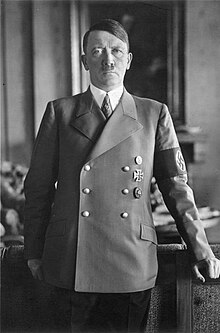Mediterranean and Middle East theatre of World War II
| Mediterranean and Middle East theatre | |||||||
|---|---|---|---|---|---|---|---|
| Part of The Second World War | |||||||
 Mediterranean in 1941 | |||||||
| |||||||
| Belligerents | |||||||
|
Main Allies |
Main Axis | ||||||
| Commanders and leaders | |||||||
|
Main Allied Leaders Allied Generals |
Main Axis Leaders Axis Generals | ||||||
The Mediterranean and Middle East Theatre was a major theatre of operations during the Second World War.
Other Belligerents[change | change source]

Allies[change | change source]
Note: NOT including main allies, colonies, former Axis Powers or resistance groups.
![]() Poland (1940 - 1945)
Poland (1940 - 1945)
![]() France (1940 - 1945)
France (1940 - 1945)
![]() Czechoslovakia (1940/1941 - 1945)
Czechoslovakia (1940/1941 - 1945)
![]() Belgium (1940 - 1945)
Belgium (1940 - 1945)
![]() Ethiopia (1941 - 1945)
Ethiopia (1941 - 1945)
![]() Canada (1943 - 1945)
Canada (1943 - 1945)
![]() South Africa (1940 - 1945)
South Africa (1940 - 1945)
![]() Greece (1940 - 1945)
Greece (1940 - 1945)
![]() Yugoslavia (6 - 17 April 1941/1941 - 1945)
Yugoslavia (6 - 17 April 1941/1941 - 1945)
![]() Brazil (1944 - 1945)
Brazil (1944 - 1945)
![]() Australia (1940/1942 - 1945)
Australia (1940/1942 - 1945)
![]() Turkey (1945)
Turkey (1945)
![]() Egypt (1945)
Egypt (1945)
![]() Saudi Arabia (1945)
Saudi Arabia (1945)
Axis[change | change source]
Note: NOT including main axis, puppet states, collaborators or co-belligerents.
![]() Hungary (1940 - 1945)
Hungary (1940 - 1945)

![]() Romania (1940 - 1944)
Romania (1940 - 1944)
![]() Bulgaria (1941 - 1944)
Bulgaria (1941 - 1944)
![]() Yugoslavia (25 - 27 March 1941)
Yugoslavia (25 - 27 March 1941)

1940 - 1941[change | change source]
On the 10th of June 1940, Benito Mussolini (the dictator of italy), declared war on France who at that time was at war with Germany, but France would surrender to the axis powers and a German puppet known as Vichy France was established.

In exile, Charles de Gaulle proclaimed Free France, an allied government-in-exile apart of the allied powers against Germany,

Mussolini decided to invade British Somaliland, and succeeded. He then invaded Egypt, and it did not succeed. After this, Mussolini attempted to invade Greece, but it failed. When 1941 began, British and commonwealth forces invaded Italian East Africa, and that would succeed.

Meanwhile Hungary, Romania, and Bulgaria joined the axis, Yugoslavia joined to, but a coup had overthrown the government, so Germany, Italy, and Hungary invaded Yugoslavia, and in 10&emdash;20 days, Yugoslavia and Greece surrendered. There was resistance all over Yugoslavia and Greece, the British had sent more troops from Egypt and Greece, so axis forces moved deeper into Egyptian territory, but an Australian force at Tobruk, prevented supplies from reaching the army’s.
Iraq set up an axis government, so British and commonwealth forces invaded Iraq, they also invaded Vichy french-controlled Syria and Lebanon.

On the 22nd of June 1941, Germany invaded the USSR, in what was known as Operation Barbarossa. The British made a supply line to the eastern front, but Iran (a country in the supply line) supported the axis, so Anglo-Soviet forces invaded Iran.
On the 7th of December 1941, Japan bombed pearl harbour, which would bring the United States in to the war.
1942 - 1943[change | change source]


In Egypt, the axis forces were pushed back, then the allied forces were pushed back, then after a battle at El Alamein, allied forces and new American forces pushed the axis forces out of africa,
On the 9th of July 1943, allied forces invaded sicily, they would reach the main land in September, meanwhile, Mussolini was ousted from power and Italy surrendered on the 8th of September, and German forces in Italy occupied Italy and established the German puppet state the Italian Social Republic, and the italian civil war began.
1944 - 1945[change | change source]

On the 17th of January 1944, the battle of Monte Cassino began, and it would last for 4 months with Rome liberated in June, the allies would march up the Italian mainland, in august, allied forces landed in southern france, meanwhile, Romania changed sides on the 24 of august as well as Bulgaria on the 8th of September.
on the 30th soviet soldiers would cross the border, helping the partisans liberating yugoslavia, in October, the British landed in shorthorn Greece to liberate the country from occupation.

In April 1945, Allied forces advanced into Italian territory, Mussolini tried to escape to Switzerland, but he was caught by Italian partisans and was executed on the 28th, two days later, Hitler commented suicide to prevent being caught by the soviet army surrounding berlin, on the 2nd of may, axis forces in Italy surrendered, and on the 8th, Germany would surrender, ending World War II in Europe.
